You can either use them as a fun activity to explore or can turn them into a science experiment using the ‘make it an experiment’ hint. We also have a downloadable experiment planner to help.
Please be careful and make sure children have adult supervision when exploring these activities. They are great fun for adults too, so join in and get involved!
Making Goo
You will need:
- Cornflour
- Mixing bowl or tray
- Food dye (optional)
(be sure to use a quantity of 2 parts cornflour to 1 part water)
Method:
- Put two cups of cornflour into a bowl or a deep tray.
- Slowly add a cup of water and mix the cornflour and water together with your hands (add two drops of food colouring if you want coloured goo).
- Roll some of the mixture into a ball between your hands. What do you notice?
- Hold some up and let it dribble through your fingers. What do you notice?
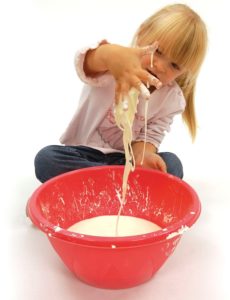
Make it an experiment:
- What will happen if you vary the water or cornflour quantity?
- Does it work with different types of flour?
- Does it make a difference if the water is warm or cold?
Science behind it:
- Cornflour is made up of lots of long stringy particles. These particles do not dissolve in water and instead move slowly around each other in water. This allows the goo to act like a solid and a liquid. When it is left to run and dribble, the particles slide slowly over each other. When you apply pressure to it, the particles join together and the goo feels solid.
Butterfly Bounce
You will need:
- A match
- Adhesive Tack
- Card and Paper
- Colouring Crayons/Felt tips
- Glue
- Needle and Thread
Method:
- Cut the head off a used match.
- Cut out a piece of card 2 match lengths long and 1 match wide.
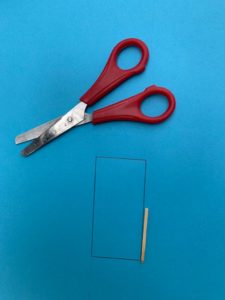
3. Press the match into some adhesive tack across the middle of the card strip. Fold up each end of the card strip.
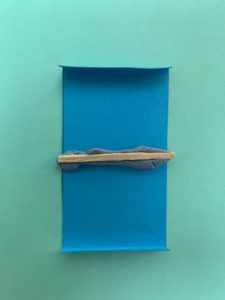
4. Draw a butterfly shape (or something else if you prefer). Make sure the butterfly is bigger than the strip of card. Cut out and decorate.
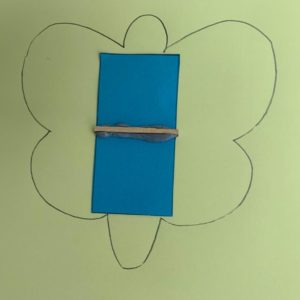

5. Glue the card onto the back and cut a piece of thread as long as your arm.
6. Using a needle, thread the cotton through the middle of the two folds on the card strip.
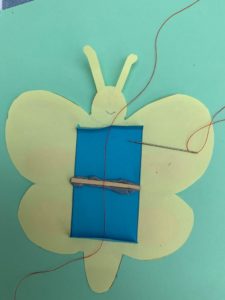
7. Hold the thread tight between your hands. Explore what happens when you pull the thread tight and then loosen it.

Make it an experiment:
- Does it make a difference if you use thicker thread?
- Does the size of the object make a difference?
Science behind it:
- When you hold the thread tight, the thread touches the match. This causes friction between the match and the thread, which stops the butterfly from moving. When you loosen the thread, it no longer touches the match, meaning there is less friction and the butterfly can easily slide down.
Erupting Volcanoes
You will need:
- Bicarbonate of Soda
- Food Colouring
- Vinegar
- A volcano made with an inner bottle/cylindrical container (be as creative as you like)
- Glitter (optional if you want a sparkling eruption)
Method:
- Build or create your volcano with a bottle/cylinder container in the middle of your volcano.
- Add two spoonful’s of bicarbonate of soda to the container.
- Add a few drops of food colouring (and glitter).
- For the explosion … Add about half a cup of vinegar into the top and watch what happens!

Make it an experiment:
- Does the shape of the volcano or container affect the eruption?
- What combination/quantity of ingredients creates the biggest eruption?
- Try adding washing up liquid – does it make a difference?
Science behind it:
- A chemical reaction takes place between the vinegar and the bicarbonate of soda which creates a gas called carbon dioxide. The gas tries to spread out and because there is not enough room in the bottle for the gas, it leaves through the opening quickly and causes the eruption.
Floating Flowers
You will need:
- Paper
- Glue
- Scissors
- Bowl and water
Method:
1.Cut a piece of paper into a 15cm x 15cm square
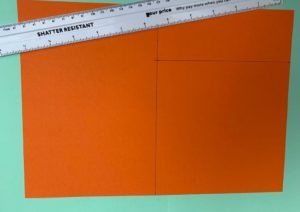
2. Fold it in half one way and then in half again.
3. Draw a petal shape outwards from the folded corners. Cut around the shape to make petals.
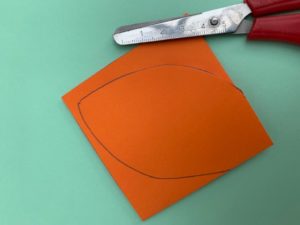
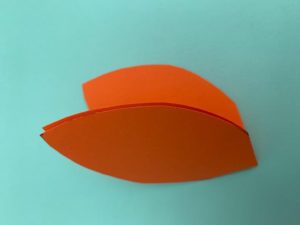
4. Open the paper and fold the tip of each petal to the middle point (where the creases cross).

5. Make a bug to sit on the middle of your flower.
6. Put the bug inside the flower and fold the petals to cover it up.
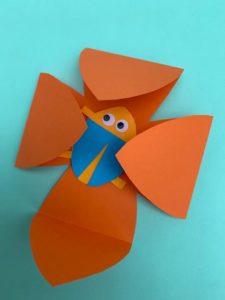

7. Fill a bowl with water. Lay the flower on top and watch what happens.
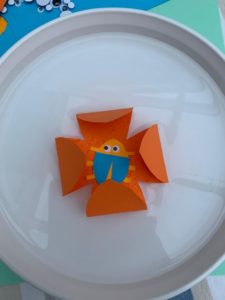
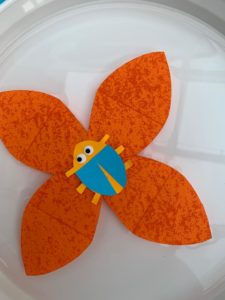
Make it an experiment:
- What happens if you use different types of paper e.g. tissue paper?
- What happens if you use different materials to make the flower?
- How big a flower can you make and it still work?
Science behind it:
- As the paper soaks up the water, the fibres in the paper swell and the paper expands. As this happens, there is movement and the flower opens.
What do you hear?
You will need:
- Thread
- Fork
- Other objects you can experiment with (e.g. metal slinky)
Method:
- Cut a piece of thread as long as your arm.
- Tie the middle to the end of a fork.
- Wind the end around your fingers (not too tightly).
- Swing the fork so that it knocks gently against the edge of a table. What do you hear?
- Now, bring the thread up to your ears and touch your index fingers to the flaps just in front of your ear holes and let the fork hang.
- Again, swing the fork so it gently knocks against the table. What do you hear?
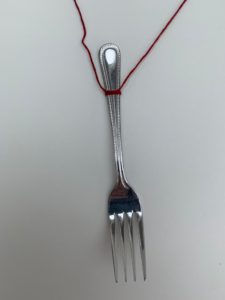
Make it an experiment:
- Explore what happens when you do this with other objects around your home, such as a metal slinky. What do you notice?
- Does the material of the object affect what you hear?
Science behind it:
- When the object (fork) hits against another, it vibrates and causes the thread to vibrate too. The air around it also vibrates too, which makes the noise. When you put the thread up to your ears, you bring the vibrations closer to your ear and you can hear the vibrations more clearly.
Have a go at these and tag us online so that we can see your science experiments!


